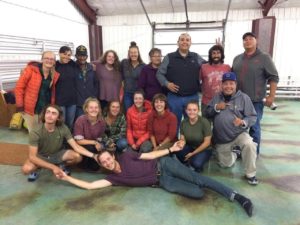 When I signed up for the Montana Afoot and Afloat course last winter, I wasn’t sure exactly what I was getting myself into, but two months of backpacking and kayaking through Montana while getting a semester’s worth of credits sounded exciting enough for me to apply. I figured I would get to see a lot of amazing views of a state that was foreign to me as well.
When I signed up for the Montana Afoot and Afloat course last winter, I wasn’t sure exactly what I was getting myself into, but two months of backpacking and kayaking through Montana while getting a semester’s worth of credits sounded exciting enough for me to apply. I figured I would get to see a lot of amazing views of a state that was foreign to me as well.
As I reach the end of my course, I can definitely say the small expectations I had have become reality. We summited above tree line in a part of the Bob Marshall Wilderness where we could see the mountains fade into the prairie. We camped alongside herds of roaming buffalo on the American Prairie Reserve. In the sacred Mission Canyon on the Fort Belknap reservation, we saw the aftermath of thousands of years of water erosion on the chiseled out rocks. We watched as Montana transitioned from long, lively summer days to the breezy, yellowy orange landscape of fall. We even caught a glimpse of winter when we climbed a clinker cliff along the Tongue River after one of the first snow falls of the season.
Although these were incredible experiences, the truth about this course, and I think maybe the outdoors in general, is not that you’ll end up in a place that blows your mind, though that might happen. It’s that those moments are few and fleeting. It’s the jokes and laughter. Deep conversations and thoughtful silence. It’s bundling together to have hot drinks on a chilly mountain side after a long day of backpacking. It’s the jokes the elder tribal members tell you around the campfire after welcoming you into their home and reservation. It’s passing around a jar of peanut butter to dip the chocolate bar your classmate shared with you to make backcountry Peanut Butter Cups. It’s the pain in your stomach from laughing so hard after biting into a Nutella wonton that surprisingly had a toy goat figurine fried in it. It’s dancing and singing Christmas songs at the top of your lungs with each other on a ridge-top in a snowstorm to avoid hypothermia. It’s being welcomed into a rancher’s home for a warm goulash meal after chatting about the future of agriculture. It’s a firm handshake from a stranger who has inspired you, a catch in your breath, a shiver when the sun slips below the horizon. It’s these little things with the people you have grown to care about that will always mean the most.
These connections and the memories of the people behind them have outweighed those of the destinations themselves. As I reminisce about the last two months of adventures, I think back to some advice Alexis Bonogofsky, a sheep rancher and environmental activist we met along the way, gave us. In order to create change we need to find what impassions each of us, whether it be the place we call home or an issue that sparks the fire in our hearts. We need to stick with it and understand all the details surrounding it better than anyone else. We need to work with the people behind it, whether they agree with you or not, and more importantly, we need to understand the reasoning why that is the case. We should work to gain their trust and discover a middle ground. Hearing the different perspectives, although it makes the issues far more complex, is how change happens.
When it comes to transitioning to sustainable agriculture, shifting economies from extractive industries to renewables, creating healthy consumer habits, and the overarching fight against climate change, we have a long road ahead of us. The growing national trends of polarization and divisiveness are only making these changes harder. These simple moments of understanding and patience that I have seen on this course are going against these negative trends. They give me hope that we can overcome our differences for our future.